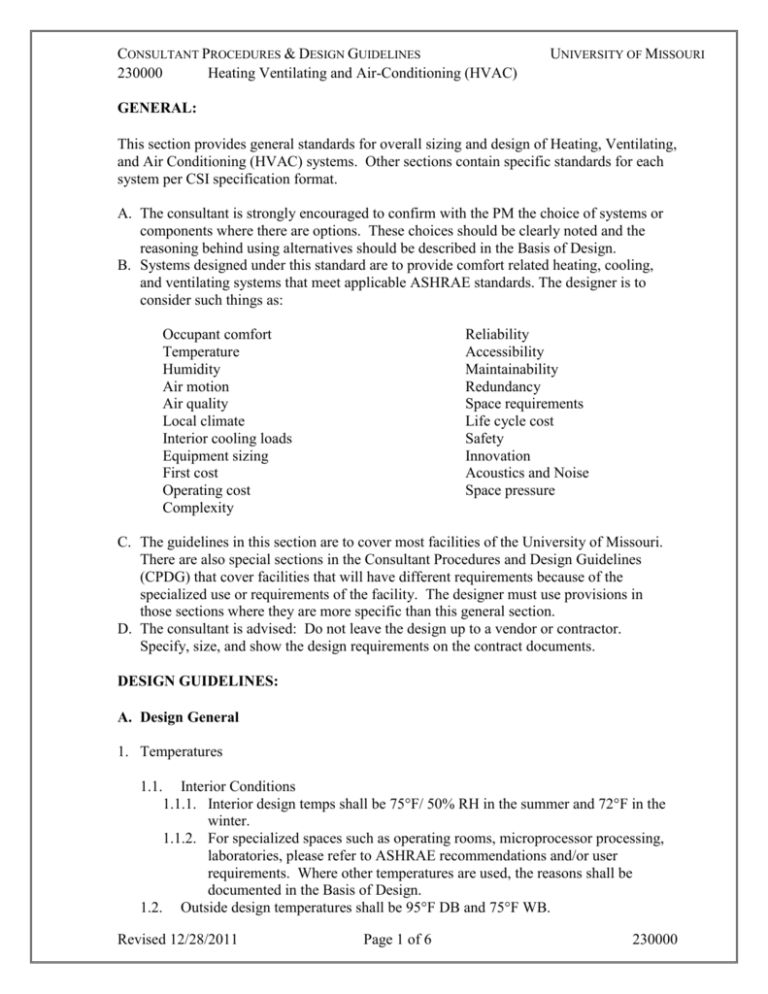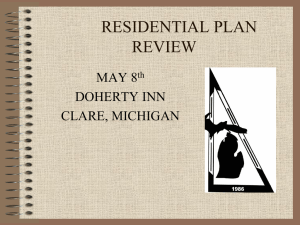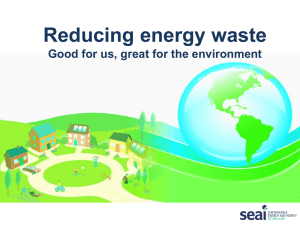Air quality - UMKC WordPress (info.umkc.edu)
advertisement

CONSULTANT PROCEDURES & DESIGN GUIDELINES 230000 Heating Ventilating and Air-Conditioning (HVAC) UNIVERSITY OF MISSOURI GENERAL: This section provides general standards for overall sizing and design of Heating, Ventilating, and Air Conditioning (HVAC) systems. Other sections contain specific standards for each system per CSI specification format. A. The consultant is strongly encouraged to confirm with the PM the choice of systems or components where there are options. These choices should be clearly noted and the reasoning behind using alternatives should be described in the Basis of Design. B. Systems designed under this standard are to provide comfort related heating, cooling, and ventilating systems that meet applicable ASHRAE standards. The designer is to consider such things as: Occupant comfort Temperature Humidity Air motion Air quality Local climate Interior cooling loads Equipment sizing First cost Operating cost Complexity Reliability Accessibility Maintainability Redundancy Space requirements Life cycle cost Safety Innovation Acoustics and Noise Space pressure C. The guidelines in this section are to cover most facilities of the University of Missouri. There are also special sections in the Consultant Procedures and Design Guidelines (CPDG) that cover facilities that will have different requirements because of the specialized use or requirements of the facility. The designer must use provisions in those sections where they are more specific than this general section. D. The consultant is advised: Do not leave the design up to a vendor or contractor. Specify, size, and show the design requirements on the contract documents. DESIGN GUIDELINES: A. Design General 1. Temperatures 1.1. Interior Conditions 1.1.1. Interior design temps shall be 75°F/ 50% RH in the summer and 72°F in the winter. 1.1.2. For specialized spaces such as operating rooms, microprocessor processing, laboratories, please refer to ASHRAE recommendations and/or user requirements. Where other temperatures are used, the reasons shall be documented in the Basis of Design. 1.2. Outside design temperatures shall be 95°F DB and 75°F WB. Revised 12/28/2011 Page 1 of 6 230000 CONSULTANT PROCEDURES & DESIGN GUIDELINES UNIVERSITY OF MISSOURI 230000 Heating Ventilating and Air-Conditioning (HVAC) 1.3. For systems using greater than 50% outside air for ventilation, the design temperatures shall be 95°F DB and 78°F WB. 1.4. For cooling towers, the design temperatures shall be 95°F DB and 81°F WB WB; Condenser water temperatures to match equipment that is selected. 1.5. Chilled water coils shall be selected based on a 14° F “Δ-T” across the coil with an inlet chilled water temperature of 46° and an outlet temperature of 60° F. Higher or lower ΔT may be desired or required by specific equipment in some circumstances. The PM shall approve of any such changes and these changes are to be documented in the Basis of Design. 1.6. Air handler cooling supply air temperatures should be delivered to the space at 55° F db and 54° F wb (max). If the air handler is a Ducted Outside Air Supply (DOAS) providing ventilation air only, the delivery temperature must be 72° F db and 60° maximum wet bulb. If the space requires temperatures lower than 75° F db and 50% RH, the supply air temperature (wb and db) must be revised accordingly. Care must be taken to prevent condensation inside air handlers and duct work where low supply air temperatures are used. Extremely low supply temperature requirements may need the application of wrap-around coils, heat wheels, or DX cooling. 1.7. Building heating systems to use 180 deg F maximum with OA temperature reset. For existing buildings, make sure that reset temperature is not too low where existing coils cannot provide heating. Check re-heat coils on VAV boxes to make sure they can provide enough heat at reset temperature to maintain spaces at minimum VAV box airflow. 2. Humidity 2.1. 2.2. 2.3. 2.4. 2.5. 2.6. Space humidity is not usually controlled directly. Summer dehumidification is a function of the cooling coil selection and the proper balance of supply and exhaust air. Design to keep the building at neutral to slightly positive air pressure. During cooling, coils are to be designed for a space condition of 75° F and 50% RH (see 1.7 above). During heating, there is no active humidity control except for specialized spaces such as hospitals, some library spaces, museums, and laboratories. Spaces that require 100% outside air shall be humidified. See the special sections in this manual for space conditions for those applications or obtain the information from the Project Manager if the type of space is not covered in the CPDG. Where humidification is used, direct steam humidification is generally used. The consultant should verify with the PM that campus steam is acceptable. If direct humidification cannot be used, a steam-to-steam generator is the preferred method of generating humidification steam. 3. Ventilation 3.1. Follow provisions in the IMC and ASHRAE Standard 62. IMC is the code and the minimum ventilation in IMC must be met even if ASHRAE allows for lower rates. Revised 12/28/2011 Page 2 of 6 230000 CONSULTANT PROCEDURES & DESIGN GUIDELINES UNIVERSITY OF MISSOURI 230000 Heating Ventilating and Air-Conditioning (HVAC) 3.2. Make sure critical space calculations have been done and include them in the Basis of Design. 3.3. Provide a DOAS air handler if the existing space does not have ventilation (existing fan coils that are not to be replaced or are replaced in kind). 3.4. Ventilation (outdoor air) is to be compared to space and building exhaust to assure that building pressurization has been obtained. 3.5. Infiltration shall be calculated and pressurization shall not be assumed to offset infiltration. 3.6. See the special sections in this manual for space conditions for those applications or obtain the information from the Project Manager if the type of space is not covered in the CPDG. 4. Load Calculations 4.1. Up to DD phase lighting loads can be done on a W/sq. ft. basis. CD loads are to be calculated on the actual lighting design and documented in the Basis of Design. 4.2. Internal gains and equipment may be estimated on a BTU/sq. ft. or W/Sq Ft. basis up to DD phase. At CD, loads shall be done based on the project design, installed components, and actual occupancy. 4.3. For special facilities, provide basis of specialized internal gains and methodology if not covered in a special section of the CPDG. 5. Energy Analysis Data (ASHRAE) 5.1. 5.2. 5.3. 5.4. Columbia: St. Louis data St. Louis: St. Louis data Kansas City: Kansas City data Rolla: St. Louis data 6. Air Handling Systems 6.1. 6.2. 6.3. 6.4. 6.5. 6.6. 6.7. 6.8. Variable volume forced air systems that comply with ASHRAE Standard 90.1 are required unless an exception is approved based on the technical requirements of the facility or as designated elsewhere in this manual for special facilities. Larger single air handlers are preferred over multiple small units. Air handlers are to be located in dedicated spaces that can be secured. Rooftop units are not to be used unless approved by the PM. Heat recovery shall be investigated and a life cycle cost done where there are high ventilation loads. Window air conditioners are to be used as a last resort and should generally only be used for temporary facilities. Fan coil systems should not be used except in renovations where low ceiling heights restrict the use of duct work. Where fan coil systems are used, outside air shall be introduced by a DOAS. Windows are not a source of required ventilation for buildings. Renovations of systems that are dual duct or multizone should convert these systems to VAV. Major renovations including these systems shall convert them to VAV. For the purposes of the definition of major or minor, a major renovation is one where over 75% of the space served by the unit is being renovated. Revised 12/28/2011 Page 3 of 6 230000 CONSULTANT PROCEDURES & DESIGN GUIDELINES UNIVERSITY OF MISSOURI 230000 Heating Ventilating and Air-Conditioning (HVAC) 6.9. All new and renovated building HVAC systems shall be provided with air filters meeting the following requirements: 6.9.1. Office and classroom : 30% pre-filter and 60% final filter (MERV 10) 6.9.2. Research labs* 30% pre-filter and 85% final filter (MERV 13) 6.9.3. All other areas shall be filtered in accordance with ASHRAE Handbook or as dictated by special conditions of the facility design. Generally, filtration shall not be less than above unless approved by the PM. *Does not include Bio-containment labs and clean rooms. See special section “Bio-containment Laboratory Design Criteria” for these requirements. 6.10. Return fans shall be provided when return/exhaust/relief duct system pressure drop exceeds 0.30” wg. 6.11. Relief fans are required whenever the economizer air relief path ΔP exceeds 0.07” Wg. (0.07” wg exerts 8 lbs of force on a 36” x 72” exterior door and will prevent the door from closing and locking) 7. Zones must be set up to contain spaces with similar usage, internal gains and skin exposures. In general, a VAV zone (box) should not serve more than three offices or similar sized rooms. Conference rooms, classrooms and larger spaces must be on their own zone apart from other spaces. Executive offices and other special spaces may be on a single zone. 8. Perimeter heating systems shall be provided when the BTU loss per ft of surface exceeds 450 BTUH/sf at the design temperature difference. Perimeter heat is essential for occupant comfort where there are high building skin losses. 9. Hydronic Systems 9.1. Chilled water is the “base” method to be used for all space cooling applications. Where chilled water is not available, the facility’s cooling needs shall be assessed and an economic life cycle of the building and systems shall be performed to select a viable system. Any system other than chilled water will require the Project Manager approval. 9.2. Hot water is the “base” method to be used for all space heating applications including 100% outside air coils (pumped coil arrangement). Other sources should only be used if there is no feasible way to provide a source of hot water. If electricity is the only heating source available, hot water heating will not be required, but may be used. Systems other than hot water require approval of the PM. 9.3. Variable flow pumping should be used for chilled water, hot water, and condenser water systems. 9.4. A means shall be included in long branches such as bypass lines with an autoflow limiting valve or limited three-way valves to keep the distribution lines at temperature during low loads. Revised 12/28/2011 Page 4 of 6 230000 CONSULTANT PROCEDURES & DESIGN GUIDELINES UNIVERSITY OF MISSOURI 230000 Heating Ventilating and Air-Conditioning (HVAC) 9.5. Pressure Independent Valves shall be used for control at chilled water coils at all AHUs. If stacked coils are used at the AHU, add calibrating balance valves at each coil. 9.6. Automatic flow limiting balance valve and a modulating control valve shall be used at all hot water coils at AHUs. If stacked coils are used at the AHU, add calibrating balance valves at each coil. 9.7. Automatic flow limiting balance valve and a modulating control valve shall be used at VAV boxes, fan coil units and terminal units. 10. Steam Systems 10.1. Steam pressure available will vary from campus to campus. The pressure available at a given site will be provided to the consultant by the PM. The pressure available will generally be above 40 psig and is sufficient for space and domestic water heating applications. 10.2. Steam powered pumps are the preferred method of returning condensate and shall be used unless directed otherwise by the PM. 10.3. Steam is the preferred source of heat on heat exchangers and can be used on heating coils, primarily on renovations, where approved by the PM. 11. Equipment Redundancy 11.1. Heating systems – unless approved by the PM, the heat generating equipment (boiler or heat exchanger) including control valves, steam traps, and pumps shall be 100% redundant (n+1). Where sources of heating other than hydronic or steam have been approved by the PM a cost/risk decision shall be made by the PM as to whether a redundant heating source is to be provided. 11.2. Cooling systems - do not need redundant capabilities, however, larger systems may require multiple pumps etc, giving some redundancy. 12. Noise and Vibration 12.1. Provide flex duct on the end of runs from the metal duct to the elbow above a diffuser for noise reduction. This flex duct should be five feet long except on lab systems where it should be five feet long and only on supply duct. 12.2. Sound levels shall be designed for background sound in rooms at the following levels or lower: Private Offices Open Offices Conference Rooms Classrooms 30 NC 35 NC 25 NC 35 NC Libraries Hospital OR Hospital Room Laboratories 30 NC 30 NC 30 NC 40 NC 13. Controls 13.1. Controls for all systems shall be DDC based on the system(s) used by the campus. The PM will advise the consultant as to which vendor(s) to use. 13.2. Pneumatic operation is preferred for large valves and dampers. Revised 12/28/2011 Page 5 of 6 230000 CONSULTANT PROCEDURES & DESIGN GUIDELINES UNIVERSITY OF MISSOURI 230000 Heating Ventilating and Air-Conditioning (HVAC) 13.3. Mixed Air Dampers, VAV boxes, reheat coils, and smaller devices shall use electric actuators. 13.4. All actuators shall fail safe and shall be specified as such. 13.5. Drawings shall show full point lists with point type. 14. Equipment Rooms 14.1. Mechanical Rooms will usually be ventilated using outside air intake louvers and a thermostatically controlled exhaust fan. Use a supply fan in lieu of an exhaust fan in rooms where atmospheric burners are located. Ventilation rate shall limit the temperature in the mechanical room to 10°F above ambient. 14.2. Electrical Rooms – Maintain temperature between 50°F and 90°F. 14.3. Telecom Rooms – Maintain temperature at nominal 75°F 15. HVAC Testing Adjusting and Balancing (TAB) will be done by an owner provided TAB Agent. The specifications shall be written accordingly. 16. Drawing Requirements 16.1. Enlarged drawings at a minimum scale of ¼” = 1’-0” will be done for mechanical spaces and congested areas. 16.2. Elevations shall be done of congested areas to show clearances. These drawings shall show pipe, duct, conduit and other services at full scale including insulation. Drawing shall note that representation includes insulation. 16.3. Floor plans to show piping, duct work and equipment on the floor where it occurs. That would mean that hydronic piping serving the first floor is shown on that drawing and A/C condensate below the second floor is shown on the same floor drawing. The consultant is encouraged to use separate sheets where systems become too congested to read the drawings at reduced scale (1/2 size). 16.4. Piping may be represented as one line up to 4” size. At 4” and larger, pipe is to be drawing to scale. When drawing 1D and 2D piping, make sure spacing of pipes allows for insulation and space between the insulation so that piping can be installed as drawn. 16.5. Schedules shall be provided for any equipment that must be specially sized. This includes items from balance valves and dampers to air handlers. All safety equipment shall be included in schedules and sized by the consultant. 16.6. Except for small renovations, provide riser diagrams of all major systems including supply air, exhaust air, chilled water, hot water, and steam. Revised 12/28/2011 Page 6 of 6 230000




